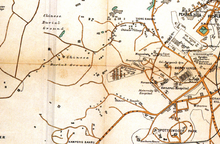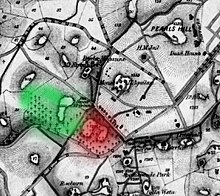Heng San Teng
The temple Heng San Teng (alternatively Heng San Ting , 恆山 亭), also called the "cemetery temple", was one of the oldest temples of the Chinese, mainly the Hoklo Chinese, in Singapore . In its immediate vicinity was a cemetery, which was particularly intended for the Chinese speaking the Hokkien dialect and was known as Tiong Lama (alternatively Teong Lama ), the "old cemetery"; it was later expanded to include the Tiong Bahru (alternatively: Teong Bahru ), the "new cemetery". The temple was built in 1828 and destroyed by fire in 1992. The temple as well as the cemeteries were located in the historical area of Bukit Merah , south of today's construction area Tiong Bahru . The name Heng San Teng Burial Ground was also used for the entire area (temple and the two cemeteries) .
history
Heng San Teng (temple)
Heng San Teng Temple was founded in 1828 by businessman Si Hood Kee , who was also one of the founders of other temples of the time. Heng San Teng's job was to manage and supervise the Hokkien Community public cemetery that was located nearby. The temple is firmly connected with the oldest Hokkien immigrant group in Singapore and was dedicated to the deity Tua Pek Kong (roughly "Great Old Man").
In 1840 the Thian Hock Keng temple was also built (by Si Hood Kee, among others) , which from then on assumed the role of the “cemetery temple ” and watched over the Tiong Lama cemetery (later Tiong Bahru). The historic Heng San Teng Temple continued to exist until it was destroyed by fire in 1992.
Tiong Lama, Tiong Bahru (cemeteries)
The spelling "t io ng" for cemetery is the usual and most used today, its origin can be found in the Hokkien language . For the spelling “t ia ng” (so in Tiang Bahru Road) there is evidence from 1863, for “t eo ng” 1875. The term “lama” is usually translated as old, “bahru” as new, both are of Malay origin. The name Tiong Bahru - presumably for the burial site or settlement - was first mentioned in the Straits Times on June 13, 1863, and Tiong Bahru Road there on February 12, 1870 (this street was first mentioned in 1913 on a map recorded). The road was formerly called Burial Ground Road and ran through an area with several Chinese cemeteries and bordered the two cemeteries in a northwest direction.
On the area southwest of Pearl's Hill there were several small, mainly Chinese, cemeteries, marked on old maps as "chinese burrial ground". One of these cemeteries, which was located between Silat Road and (later) Hospital Road, became the central burial place of the Singaporean Hokkien Chinese and was in the immediate vicinity of the Heng San Teng temple. The temple was built in 1828 to oversee the burial site. The then town builder Carrington reported in 1875 that around 1859 there was an expansion of the cemetery in a north-westerly direction to include an area that was later called Tiong Bahru. According to his estimate, with around 500 funerals taking place at the time, it could be assumed that there would be enough space for the next ten years. It was around this time that the terms Tiong Lama and Tiong Bahru emerged in order to distinguish between the “old” and the “new” cemetery.
Another change came in 1882 in connection with the move of the General Hospital to Sepoy Lines on Outram Road, whereby parts of the hospital, namely the Maternity Hospital and the so-called "Lunatic Asylum" (psychiatric sanatorium, built in 1887), should arise in the area of the two cemeteries Tiong Lama and Tiong Bahru. There were significant changes at the beginning of the 20th century. In the city administration there was increasing discussion about the redesign of the area, called around the time Kampung Tiong Bahru, the Singapore Improvement Trust (SIT) should realize the plans. The wild settlements and burial places should be closed. While the residents were moving into new apartments built by SIT, the cemeteries were exhumed. This was partly on the initiative of the Hokkien Huay Kuan Association , and the graves were transferred to the Bukit Brown cemetery. This work was finished in 1930, but the remains of the graves can still be found on the hospital grounds.
location
All objects, the Heng San Teng Temple, the "old cemetery" Tiong Lama and the "new cemetery" Tiong Bahru, were in the Bukit Merah area , southwest of Pearl's Hill:
- The temple was located at the junction of Silat Road and Kampung Bahru Road, not far from the Singapore General Hospital (SGH). On a map from 1913 (see Figure 1), the lower half of the Heng San Teng temple is shown in the middle as the “Chinese Temple”. In the upper part you can see the Chinese settlement Tiong Bahru on Burial Ground Road (later Tiong Bahru Road).
- The Tiong Lama burial site was located on the site of the Maternity Hospilal at the time, and Tiong Bahru northwest of it to the Lunatic Asylum (insane asylum). Their position in relation to one another can be seen on a map from 1860 (see Figure 2, red for Tiong Lama, green for Tiong Bahru).
Remarks
- ↑ Also known as See Hoo Kee, See Hoot Kee, Si Hoo Keh, Sit Hoot Kee and See Hood Kee.
Individual evidence
- ↑ Hue Guan Thye: Chinese temples and transnational networks: Hokkien communities in Singapore , MMG Working Paper 16-06, Max Planck Institute for Research into Multi-Religious and Multi-Ethnic Societies, Göttingen 2016, ISSN 2192-2357, online at: mmg.mpg. de / ...
- ↑ a b Summary report of the National Archives of Singapore, National Library Board, Government of Singapore, online at: nas.gov.sg / ...
- ↑ Jaime Koh: Hokkien Huay Kuan , National Library Board, Government of Singapore, online at: eresources.nlb.gov.sg/.../SIP_2016-04-07_163620
- ↑ a b c Fragments of the old tiong , private website, online at: thelongnwindingroad ...
- ^ Ng Yew Peng: What's In The Name? How The Streets And Villages In Singapore Got Their Names , World Scientific, September 28, 2017, page 419, online at: books.google.de / ...
- ↑ a b c Tiong Bahru , Report of the National Library Board, Government of Singapore, online at: eresources.nlb.gov.sg/...2010-08-11
- ↑ a b c d e f g Tiong Bahru Heritage Trail , a publication of the National Heritage Board, a portal of the Government of Singapore, online at: www.nhb.gov.sg
- ↑ Tramping in Tiong Bahru , private website, online at: avignettist.com

